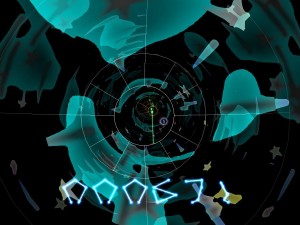Brainpipe
 While I’m talking about AaaaaAAaaaAAAaaAAAAaAAAAA!!!, I might as well pull out its cousin, Digital Eel’s Brainpipe: A Plunge to Unhumanity (which, for some reason, my brain insists on resubtitling Brainpipe: A Thrashing Parity Bit of the Mind). It’s another game in the flying-unstoppably-forward genre, like Space Harrier and the Death Star trench run in any Star Wars game, but unlike those, and like AaaaaAAaaaAAAaaAAAAaAAAAA!!!, you don’t shoot at stuff. The action is all about dodging things at high velocity.
While I’m talking about AaaaaAAaaaAAAaaAAAAaAAAAA!!!, I might as well pull out its cousin, Digital Eel’s Brainpipe: A Plunge to Unhumanity (which, for some reason, my brain insists on resubtitling Brainpipe: A Thrashing Parity Bit of the Mind). It’s another game in the flying-unstoppably-forward genre, like Space Harrier and the Death Star trench run in any Star Wars game, but unlike those, and like AaaaaAAaaaAAAaaAAAAaAAAAA!!!, you don’t shoot at stuff. The action is all about dodging things at high velocity.
Actually, it’s not quite a game about flying forward unstoppably. You can stop briefly; holding down a button lets you take a moment to reorient yourself and/or heal up after a crash. (Like in a lot of recent first-person shooters, you heal very quickly; death only comes if you have several crashes in rapid succession.) Release the button and you’re immediately back to normal speed. The stopping power is somewhat elastic, and you stretch back into normal speed if you keep the button held down. In effect, you’re using up your stop energy. It takes a little while to build up again, and until it does, you can’t stop as effectively. It’s a strange and unnatural-feeling mechanic.
But strange and unnatural-feeling is exactly what the authors want. The high concept here is essentially that this is a videogame designed by aliens. In fact, it’s implied to be an alien mind-alteration device, its trippy visuals and disorienting sound design having a permanent effect on the player’s brain. The various levels (all essentially the same thing at increasing difficulty) have names that are slightly-altered terms from neuroanatomy (Nasal Ganglia, Psynaptic Gap, etc), and the end of each level has a glyph that, if you collect it, tells you that you have “achieved” some mental state: the first is Awareness, which makes it seem like this is going to be a quest for enlightenment, but it’s followed up by things like Dissonance and Confusion. One of the levels grants you Transhumanity, which looks promising, but the next grants you Subhumanity. Well, no one ever said that changing your brain was ultimately going to be positive. You’re the one who wanted to do this, man. At the end of level 10, in a moment like the end of that Death Star trench run, you have one chance to nab the Unhumanity glyph or wind up in a coma. If you get it, you get to choose your new alien form, from a list of pictures taken from previous Digital Eel games (mostly from their mini-space-opera Weird Worlds).
The UI design has some alien touches. The numbers in the score display morph from digit to digit instead of flipping instantly — and since you score points just for moving forward, this means that the ones place never looks quite like a number. The health bar is not a health bar but a health sphincter: there’s a circular reticle that shows you where you’re aiming, and as you lose health, the reticle’s iris turns red and dilates. There’s eye imagery in the menus outside of the game as well — every button is an eye that pivots to look at the cursor, which means that you need to touch an eye to play the game, or even to quit it. Alternately, you could see the player as a one-eyed monster in the euphemistic sense, trying to penetrate the deepest reaches of a tube. Couple that with the alien mind alteration bit and it’s even oogier.
The one thing I like the best about this game is the sound design. The various obstacles have associated sound effects that bend in pitch Doppler-wise as they zoom to the rear. On top of that, there’s a constantly shifting array of background noises — elevator music, snatches of conversation that you can’t quite make out, TARDIS dematerialization sounds, the manic bonus music from Mr. Do. None of which ever last for more than ten seconds at a time. It produces a sense of dizziness, like that produced by hyperventilation or anaesthesia — a sense that you’re not currently fit to understand what’s going on around you. If there was any doubt that Caillois’ ilinx could be produced by a videogame, Brainpipe should settle it.
Brainpipe‘s linearity, short length, and focus on a single play style makes it seem a lot like a coin-op arcade game, as do the glowy colors. In fact, I’d kind of like to see an arcade cabinet for this game, preferably with a bunch of teenagers crowded around it in a dingy and disreputable arcade, next to the Polybius machine.
 Comments(0)
Comments(0)